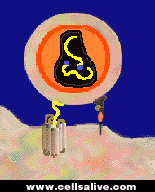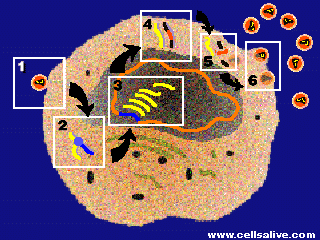
On the surface membrane of all living cells are complex protein structures called "receptors". A receptor is often compared to a lock into which a specific key or "ligand" will fit. There are at least two receptors on T-lymphocytes to which the human immunodeficiency virus (HIV) sticks. The primary receptor, called "CD4", is shown on the right in the diagram. But a second receptor that loops through the cell membrane 7 times is critical for infection to occur.
HIV infection of a lymphocyte requires attachment of the virus to the cell membrane through both of these "ligand-receptor" links. In cells whose "7-transmembrane receptor" is different, the HIV "key" no longer matches the lymphocyte "lock" and attachment is incomplete. Those cells may avoid infection by HIV.

